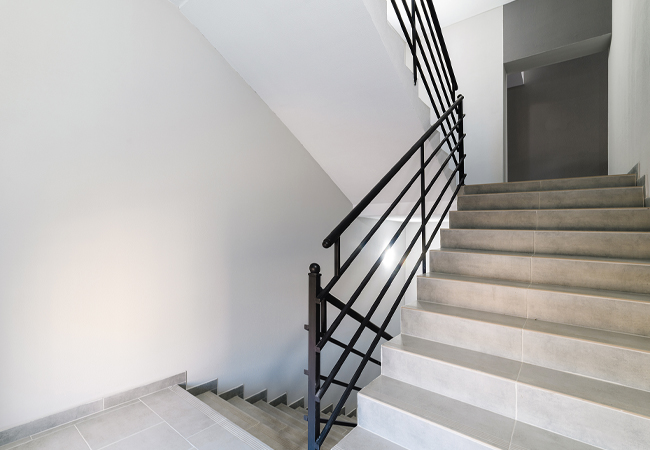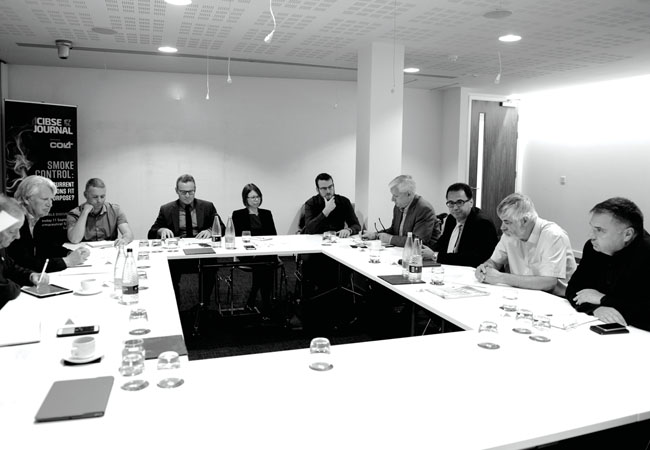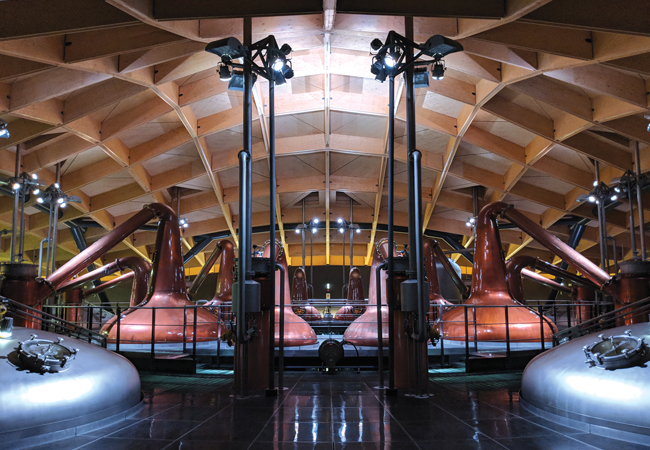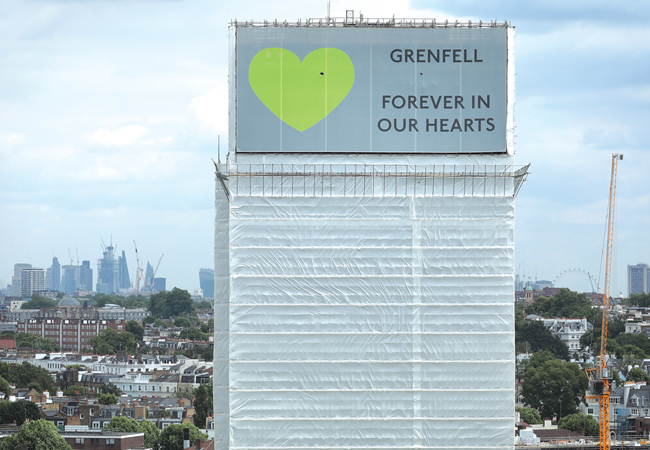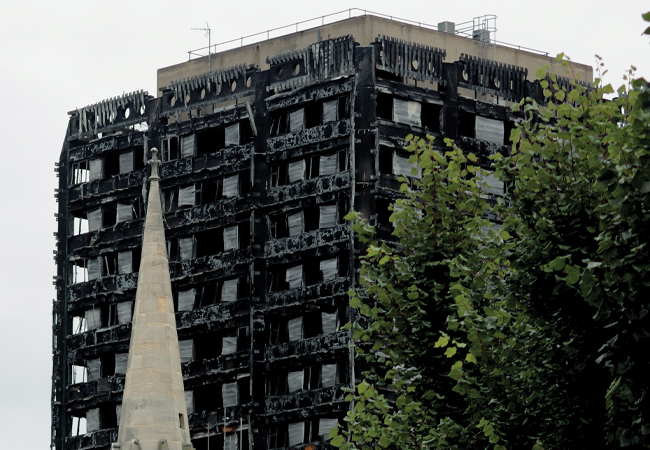
This note provides a summary of the Phase I Report of the Public Inquiry into the Grenfell Tower fire, published on 30th October 2019.
The Rt Hon Sir Martin Moore Bick has published his report on Phase 1 of the public inquiry into the fire at Grenfell Tower on 14th June 2017. The report is published in four volumes, which are available online here: https://www.grenfelltowerinquiry.org.uk/phase-1-report.
The report is long, running to nearly 840 pages, and comprehensive. This summary focuses on those aspects of the report that consider Building Regulations. This is not intended to detract in any way from the other important aspects of the report, which have attracted considerable attention in the media.
However, from a CIBSE perspective, this is the primary technical aspect of the report, which contains Sir Martin’s initial recommendations and also outlines the areas for further consideration in Phase 2 of the Inquiry. That aspect bears close reading.
Volume 1 is described as covering ‘background matters,’ and includes the executive summary and introductory chapters. Volumes 2 and 3 cover the events of 14th June in some detail, and Volume 4 summarises what Phase I has established and the recommendations which Sir Martin is making at this stage.
Key elements of the report on Building Regulations are at paragraph 2.16 in the executive summary, and in chapter 5 and chapter 26. There is also a chapter in Volume 1, which summarises the findings and changes to fire service procedures arising from the Lakhenal House fire in 2009, but it does not make reference to the coroner’s findings in relation to the Building Regulations, which may be expected to feature in Phase 2.
The recommendations appear in Chapter 33, and include a conclusion about the cladding and the spread of the fire. Chapter 34, which may be the most significant from a Building Regulations perspective, sets out the main topics for further investigation in Phase 2 of the Inquiry.
From a Building Regulations perspective it is worth noting the following points. Chapter 5 is a very good summary of the legislative structure at present. Sir Martin is very clear that the functional requirements of Building Regulations are set out in Schedule 1 of the 2010 Regulations (as amended), and that for the cladding B4 is the key. He also notes the importance of B3 on compartmentation.
Although it was not his original plan to do this, Sir Martin has concluded that in law the external cladding did not meet building regulations. He is clear that he did not intend to reach a conclusion on that point in Phase I, but he has found the evidence overwhelming.
He concludes that the cladding did not comply with functional requirement B4 to prevent the external spread of fire, ‘but actively promoted it’.
His summary in paragraph 2.16 is concise, comprehensive and quite categoric, and reads as follows:
It was not my original intention to include in Phase 1 of the Inquiry an investigation into the extent to which the building complied with the requirements of the Building Regulations. However, as I have explained in Chapter 26, there was compelling evidence that the external walls of the building failed to comply with Requirement B4(1) of Schedule 1 to the Building Regulations 2010, in that they did not adequately resist the spread of fire having regard to the height, use and position of the building. On the contrary, they actively promoted it. It will be necessary in Phase 2 to examine why those who were responsible for the design of the refurbishment considered that the tower would meet that essential requirement.
As noted in the text above, there is more detail (two pages) in Chapter 26 in Volume 4, which expands Sir Martin’s reasoning. The conclusions in Chapter 23 are also very relevant, and the whole chapter, which details the development of the fire in the façade, is almost certainly required reading by any façade or fire engineer, that should be undertaken and recorded as CPD activity at the earliest opportunity. Paragraph 23.61 is also worth noting here, as it makes clear that there is to be significant work in Phase 2 on the issues of fire spread and materials.
23.61 I accept the evidence of Professor Bisby and Professor Torero that the Grenfell Tower fire was unusual in the way that it spread laterally and was able to envelop the entire building in under three hours.
With that in mind, I intend in Phase 2 of the Inquiry to examine (among other things) the extent to which the regime for testing materials intended for use in external walls (including thermoplastic polymer materials such as polyethylene) and the regulations governing their use were, and are, adequate to identify and control the potential dangers from downward and horizontal as well as vertical flame spread.
I shall also examine what was and should have been known, both by those in the construction industry and by those in central government responsible for setting fire safety standards, about the particular dangers posed by thermoplastic polymers.
Sir Martin then moves in Chapter 33 to the recommendations. There is more there that relates to Building Regulations, starting in para 33.4, which reads as follows:
33.4 In England and Wales, high-rise buildings have conventionally been defined for the purposes of fire safety as buildings over 18 metres in height. In Scotland, however, the regulations have recently been changed so that the requirements relating to high-rise buildings apply to buildings over 11 metres in height. It is for consideration whether the position in England should now also be changed and, if so, what height should be adopted for that purpose. However, that question was not the subject of examination in Phase 1 and it is therefore not possible for me to make a recommendation about it at this stage. It is, however, a matter that will be examined in Phase 2.
This is relevant to the current consultation on extending the requirement for sprinklers in high-rise buildings. That offers two options – 18m or 11m, although the evidence base for those heights is unclear. This recommendation can be expected to prompt further consideration and scrutiny of the various trigger heights contained in Part B and the associated guidance. It will have a direct bearing on the current and ongoing review of Part B of the building regulations. We can expect this to be scrutinised in detail at the Inquiry in the next Phase. It is likely to have implications for CIBSE Guide E in the longer term.
Para 33.6 is long, and well reasoned, amounting to a very public call on MHCLG and Ministers to get the 400 other ACM clad buildings made safe without delay. It could be paraphrased as ‘we all know what needs doing – just do it’!
In 33.7 Sir Martin makes comments related to the recent changes in Regulation 7 around restrictions on the use of combustible materials and concludes
I do not think it appropriate at this stage for me to recommend any change to the regulations in this respect. Nor, for similar reasons, do I think it appropriate for me to recommend an immediate moratorium on the use of materials of Euro class A2 pending the outcome of Phase 2 of the Inquiry, despite the submissions pressed upon me by some of the core participants.
Not for the moment, but this topic is clearly going to come under close scrutiny in Phase 2, and we can expect further discussion about the detail of Regulation 7.
On testing and certification of materials, and it is worth quoting the paragraph in full here:
Testing and certification of materials
33.8 The regulation of the use of materials and products by reference to their fire classification depends to a large extent on the efficacy of the testing requirements and how they are interpreted by professionals.
Early in Phase 2, the Inquiry will investigate the methods of testing and certifying materials for use in high-rise buildings. It will also investigate whether a prescriptive regime is the most effective way in which to ensure the safety of those who live and work in high-rise buildings and whether the current guidance on how to comply with the Building Regulations is sufficiently clear and reliable.
None of those questions have been examined in Phase 1 and at this stage, therefore, I am not in a position to make any recommendations about any of those matters.
This certainly raises the prospect of recommendations to move away from the current functional requirements to a prescriptive approach in certain respects. Given the difficulty that the prescriptive nature of the Regulation 7(2) and the exemptions in Regulation 7(3) has caused, this will be a very significant regulatory discussion in Phase 2.
Sir Martin considers aspects of building information needed to enable the Brigade to fight a fire and evacuate a building, many of which were sadly lacking at Grenfell Tower. Without using the term, he calls for an enhanced version of the information already required by Regulation 38, coupled with a digital model as Dame Judith Hackitt has called for in her Review of Building Regulations.
If explored more fully, this may extend to consideration of enforcement and compliance aspects of regulations, and possibly into the discussion about digital futures for building regulations and building safety. In this respect it may be relevant to the Society of Digital Engineering (SDE) within CIBSE.
Again, without using the term, Sir Martin calls for greater use of Building Information Modelling.
I also recommend, insofar as it is not already the case, that all fire and rescue services be equipped to receive and store electronic plans and to make them available to incident commanders and control room managers.
BSI are already developing a standard on this, and CIBSE and the SDE are engaged in the work.
Section 7 addresses lifts, and recommends regular and frequent checks on the functioning and emergency control aspects of lifts and reporting of the results monthly to the fire service.
Section 12 of the conclusions, on evacuation, makes several recommendations, including that there be a means of signalling a call to evacuate throughout the building, and for evacuation plans to be held digitally. Again, BSI are working on this already.
Section 14 deals for the time being with sprinklers, stating that there is insufficient evidence, to support immediate recommendations, and placing the topic firmly into Phase 2.
Sprinkler systems
33.25 The coroner who conducted the inquests arising out of the Lakanal House fire heard evidence about the installation of sprinklers and recommended that the government encourage housing providers responsible for high-rise buildings containing multiple domestic premises to consider fitting them. It is not surprising, therefore, that some core participants have urged me to go a step further and to recommend that such systems be installed in all existing high-rise residential buildings.
33.26 Sprinkler systems no doubt have a very valuable part to play in the overall scheme of fire safety measures, but whether such a system would be likely to have suppressed the fire in Flat 16 or prevented it from escaping into the cladding before the firefighters could extinguish it is not something that was investigated in Phase 1. I have therefore heard no evidence about the use of sprinklers generally, their effectiveness under different conditions, or about the cost and disruption that would be caused by installing them in existing buildings. In those circumstances, I cannot make any recommendation at this stage about the installation of sprinklers in existing buildings, although the government’s response to previous recommendations will form an important part of the investigation to be carried out at Phase 2.
Section 16 tackles fire doors, recommending mandatory and retrospective replacement of fire doors in buildings with unsafe cladding. It also proposes quite stringent statutory requirements on building owners of ALL residential buildings, which are not single-family residences. This is quite far-reaching.
It is already clear that there is going to be a need for some significant upskilling in certain areas to enable building owners and occupiers to get the expert services that are going to be needed to do the various new statutory checks and tests that Sir Martin recommends.
Phase 2 – what can we expect?
Sir Martin then turns his attention in Chapter 34 to the next phase of the Inquiry. In 34.4 he says that
the principal focus of Phase 2 will be on the decisions which led to the installation of a highly combustible cladding system on a high-rise residential building and the wider background against which they were taken.
But he adds that there are a number of other matters of significant concern, which he then elaborates. He begins with those relating to the LFB before a lengthy paragraph on testing and materials, which also makes reference to the Regulations and Approved Documents.
Testing and certification of materials
34.7 In the light of the expert evidence, in particular Dr Barbara Lane’s supplemental report, there are already grounds for thinking that the current regime for testing the combustibility of materials and cladding systems, particularly those chosen for use in high-rise buildings, maybe neither as rigorous nor as effectively enforced as it should be.
Doubts have also arisen about the reliability of the certification of certain materials for use in high-rise buildings.
Grave concern inevitably arises simply from the fact that it was possible for highly combustible materials to be used for the purposes of refurbishing and cladding a building like Grenfell Tower.
How that was possible is a question that may be relevant to many aspects of the construction industry, including manufacturers of products currently widely available on the market.
Pending further investigation, it would clearly be sensible for anyone who is responsible for the fire safety of an existing building or who is considering the use of products on high‑rise buildings to scrutinise the information about them provided by the manufacturers and exercise considerable care to ensure that they meet the required standards.
These concerns extend to the adequacy of the regulations themselves, the quality of the official statutory and non-statutory guidance currently available, the effectiveness of the tests currently in use, the arrangements for certifying the compliance of materials with combustibility criteria and the manner in which materials are marketed.
They are questions that will lie at the heart of the Inquiry’s investigations in Phase 2.
Design and Choice of materials are covered separately, but this paragraph envisages an examination of the Building Regulations and the associated guidance in the Approved Documents. Fire doors, window arrangements, lifts and smoke extraction are all in the list of Phase 2 topics, too. So there is much more to come, I think, and we must expect significant technical issues to be raised in Phase 2.
Sir Martin goes on to say that Phase 2 will not consider the capacity of the stairs, the electricity supply or the gas supply, other than the contribution that incomplete gas installation work may have made to the spread of smoke.
Clearly there is much more in the report than can be summarised in 4 pages. It includes the human aspects of the tragedy that unfolded at Grenfell, of which we are very mindful. However, this note does identify the key findings relating to the technical aspects of the fire, and will assist CIBSE members in a range of disciplines to understand these aspects of the report.

